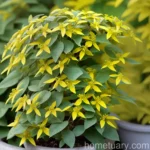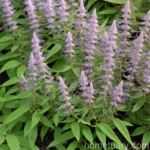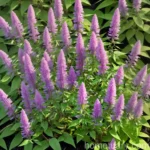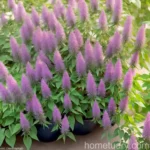Bush Clover (Lespedeza japonica): A Comprehensive Planting Guide
Plants have been an integral part of our lives for centuries. They are not only visually appealing but also play a crucial role in maintaining ecological balance. Among the vast array of plant species, the bush clover (Lespedeza japonica) stands out as an intriguing and versatile plant with a rich cultural and ecological significance. In this comprehensive planting guide, we will explore the key aspects of bush clover, providing valuable insights into its culture, uses, care techniques, and much more.
What is Bush Clover (Lespedeza japonica)?
Bush clover, scientifically known as Lespedeza japonica, is a deciduous perennial plant that belongs to the Fabaceae family. It is native to East Asia, particularly Japan, Korea, and China. This plant is renowned for its ornamental value, ecological benefits, and various uses in traditional medicine and landscaping.
Key Takeaways – Bush Clover (Lespedeza japonica)
Before delving into the detailed aspects of bush clover, let’s take a quick look at its primary characteristics and significance:
- Botanical Name: Lespedeza japonica
- Family: Fabaceae
- Native Habitat: East Asia
- Plant Type: Deciduous perennial
- Uses: Ornamental, ecological, medicinal
- Features: Showy flowers, nitrogen-fixing properties, wildlife attraction
Culture of Bush Clover
Understanding the culture of bush clover is essential for successfully growing and maintaining this plant. This encompasses the environmental conditions, care requirements, and its ecological role.
Uses
Bush clover exhibits a range of uses that make it a valuable addition to diverse settings:
-
Ornamental: The attractive, pea-like flowers and fine foliage of bush clover make it a charming addition to gardens, landscapes, and naturalized areas. It adds color and visual interest, particularly in late summer and fall when many other plants have completed their flowering cycles.
-
Ecological Benefits: As a leguminous plant, bush clover has the remarkable ability to fix nitrogen in the soil through its symbiotic relationship with nitrogen-fixing bacteria. This makes it a valuable contributor to soil fertility and overall ecosystem health. Additionally, it serves as a habitat and food source for various pollinators and wildlife.
-
Medicinal: Some traditional herbal medicine systems attribute therapeutic properties to bush clover. It has been used for its potential health benefits, although further scientific research is needed to validate these claims.
Water
Bush clover generally prefers moderate moisture levels, although it exhibits good tolerance to periods of drought once established. Adequate watering, especially during the initial establishment phase, is crucial for promoting healthy growth and flowering.
Key Points:
– Initial Establishment: Provide regular watering during the first growing season to aid in root development and establishment.
– Mature Plants: Once established, bush clover is relatively tolerant of drought, requiring less frequent watering. However, during prolonged dry spells, supplemental irrigation can promote better flowering and overall vigor.
Sunlight
Bush clover thrives in full sun to partial shade conditions. Adequate sunlight is essential for stimulating robust flowering and maintaining healthy foliage. It can tolerate some shade, but full sun exposure is ideal for optimal growth and flowering.
Sunlight Requirements:
– Full Sun: 6-8 hours of direct sunlight per day
– Partial Shade: Tolerates light to moderate shade, especially in warmer climates
Fertilizer
As a legume, bush clover has the remarkable ability to fix atmospheric nitrogen, reducing the necessity for nitrogen-based fertilizers. However, it can benefit from a balanced, general-purpose fertilizer, particularly during the early stages of growth and flowering.
Fertilization Guidelines:
– Early Spring: Apply a balanced fertilizer with an NPK ratio of 10-10-10 or similar, following the recommended application rates based on soil conditions and plant vigor.
– Avoid Excessive Nitrogen: Due to its nitrogen-fixing abilities, excessive nitrogen fertilization can be counterproductive and may lead to reduced flowering and overall plant health.
Soil
Bush clover demonstrates good adaptability to various soil types, ranging from loamy to sandy soils, as long as they are well-draining. It is relatively tolerant of different soil pH levels and can thrive in neutral to slightly acidic conditions.
Soil Preferences:
– Drainage: Well-draining soil is essential to prevent waterlogging and root rot.
– pH Range: Accepts a wide pH range, ideally between 6.0 and 7.5.
Pruning Bush Clover
Pruning is a key aspect of bush clover maintenance, contributing to its overall appearance, vigor, and flowering performance. Proper pruning techniques can help control its growth, promote a more compact form, and encourage abundant flowering.
Pruning Techniques:
– Regular Deadheading: Remove spent flowers to prolong the blooming period and prevent the formation of seed pods. This encourages the plant to allocate its energy towards continual flowering.
– Spring Pruning: In late winter or early spring, prune back the previous year’s growth to around 6-8 inches above ground level. This stimulates new growth and enhances the plant’s overall shape.
Propagation of Bush Clover
Propagation of bush clover can be accomplished through several methods, including seed propagation, division, and softwood cuttings. Each technique has its specific requirements and best suited timing for successful propagation.
Methods of Propagation:
-
Seed Propagation: Bush clover can be propagated from seeds, although it requires stratification to break dormancy and promote germination. Sow seeds outdoors in fall or early spring for best results.
-
Division: Established clumps of bush clover can be divided in early spring, before new growth begins. This method helps rejuvenate older plants and create new individuals for transplanting.
-
Softwood Cuttings: Taking softwood cuttings in late spring or early summer can yield new plants with genetic traits similar to the parent. Provide a humid, warm environment to encourage rooting and subsequent growth.
Container Gardening with Bush Clover
While bush clover is often grown in traditional garden beds and naturalized areas, it can also thrive in containers, providing an attractive and versatile option for small-scale gardening and ornamental displays.
Popularity in Containers
Bush clover’s adaptability and aesthetic appeal make it well-suited for container gardening, enabling individuals with limited space or specific design preferences to enjoy its beauty and ecological benefits.
Container Considerations:
– Size: Select containers with ample room for root development and stability. Larger containers promote healthier growth and reduce the need for frequent repotting.
– Drainage: Ensure containers have adequate drainage holes to prevent waterlogging and root rot.
– Soil: Use well-draining, quality potting mix suitable for perennials. Incorporate organic matter for improved moisture retention and nutrient availability.
Common Diseases of Bush Clover
While bush clover is relatively disease-resistant, it can occasionally encounter specific fungal infections, particularly in conditions of high humidity, poor air circulation, or overly moist soil. Understanding common diseases and their management is crucial for maintaining plant health.
Disease Diagnosis
Some of the common diseases that may affect bush clover include:
-
Powdery Mildew: This fungal disease presents as a powdery white covering on the leaves, often leading to stunted growth and reduced flowering. It thrives in humid conditions and can be managed through cultural practices and fungicidal treatments.
-
Root Rot: Overly soggy or waterlogged soil can lead to root rot, causing wilting, yellowing foliage, and eventual decline. Proper drainage and avoiding overwatering are essential for prevention.
-
Leaf Spot: Various fungal pathogens can cause circular or irregular spots on the leaves, leading to unsightly foliage and potential loss of vigor. Pruning affected plant parts and ensuring good air circulation can help manage leaf spot diseases.
Disease Prevention
Implementing proactive measures to prevent common diseases is vital for safeguarding bush clover against potential infections and minimizing overall management efforts.
Preventive Strategies:
– Pruning: Regularly remove any diseased or damaged plant parts to prevent the spread of pathogens.
– Air Circulation: Maintain adequate spacing between plants and avoid overcrowding to promote good air circulation.
– Watering: Practice sound watering practices, focusing on the base of the plant to minimize foliage wetting.
– Fungicidal Treatments: In severe cases or recurring infections, consider using appropriate fungicides following label instructions.
Common Pests Affecting Bush Clover
While generally resilient to pest infestations, bush clover can sometimes encounter specific insect pests that may impact its growth and overall performance. Familiarizing oneself with common pests and their management is essential for maintaining plant health.
Common Pests
Some of the notable pests that may affect bush clover include:
-
Aphids: These small, soft-bodied insects can cluster on new growth, sucking plant sap and causing distortion and yellowing of leaves. Natural predators and insecticidal soaps can help control aphid populations.
-
Japanese Beetles: The adult beetles feed on the foliage, often causing skeletonization of the leaves and compromising the plant’s aesthetic appeal. Handpicking and using beetle-specific traps are common management strategies.
-
Caterpillars: Certain caterpillar species can feed on the foliage and stems, leading to noticeable defoliation and potential stress on the plant. Bacillus thuringiensis (Bt) and manual removal can control caterpillar populations effectively.
Pest Control
Employing integrated pest management (IPM) practices can help mitigate pest issues while minimizing the reliance on chemical treatments and promoting ecological balance.
IPM Strategies:
– Monitoring: Regularly inspect plants for pest activity, focusing on the undersides of leaves and new growth.
– Natural Predators: Encourage the presence of beneficial insects and birds that feed on pest species.
– Cultural Controls: Maintain plant health through optimal cultural practices to mitigate pest susceptibility.
– Selective Treatments: If necessary, utilize targeted insecticidal treatments that pose minimal impact on non-target organisms.
Botanist’s Tips for Successful Bush Clover Cultivation
Based on scientific insights and practical experiences, here are several valuable tips to ensure successful cultivation and enjoyment of bush clover in diverse settings:
-
Site Selection: Choose a well-drained, sunny to partially shaded location for planting bush clover, ensuring adequate space for its mature size.
-
Adequate Watering: Provide consistent moisture, particularly during the establishment phase, to promote healthy root development and flowering.
-
Regular Deadheading: Engage in regular deadheading of spent flowers to extend the flowering period and encourage continual blooms.
-
Pruning Technique: Employ proper pruning techniques, particularly in late winter or early spring, to maintain a more compact form and stimulate new growth.
-
Integrated Pest Management: Practice vigilance in monitoring for potential pests and implement ecological pest control strategies to manage infestations effectively.
-
Companion Planting: Consider companion plants that complement the growth habits and ecological preferences of bush clover, creating harmonious and visually appealing plant communities.
Fun Facts about Bush Clover
To further appreciate the unique characteristics of bush clover, here are some intriguing and informative fun facts about this remarkable plant:
-
Cultural Significance: In Japan, bush clover is celebrated during the festival of Higan, representing the arrival of autumn and featuring prominently in traditional poems and art.
-
Food Source for Wild Animals: Its seeds serve as a valuable food source for various wildlife, including birds and small mammals, contributing to ecological diversity.
-
Land Conservation: Bush clover is utilized in certain habitat restoration and conservation projects for its ability to enhance soil fertility and provide habitat for pollinators.
-
Seasonal Transitions: The foliage of bush clover undergoes a stunning transformation in the fall, displaying vibrant hues of red, orange, and yellow, adding a delightful touch to autumn landscapes.
Links to External Resources
To further expand your knowledge and resources on bush clover (Lespedeza japonica), explore the following links:
Gaining insights from reliable sources and fellow gardening enthusiasts can enhance your understanding and appreciation of this fascinating plant!
In conclusion, bush clover (Lespedeza japonica) exemplifies a plant of immense ecological value, ornamental beauty, and cultural significance. By assimilating the knowledge and guidelines provided in this comprehensive planting guide, individuals can effectively cultivate and appreciate the myriad benefits of this remarkable perennial in their gardens, landscapes, and naturalized areas.
Remember to share this guide with fellow plant enthusiasts, and embark on a journey of discovering the captivating world of bush clover cultivation and appreciation!
References
-
“Growing Lespedeza japonica” Gardening Know How. Available online: https://www.gardeningknowhow.com/ornamental/shrubs/lespedeza/growing-japanese-bush-clover.htm
-
“Lespedeza japonica” USDA Forest Service. Available online: https://www.fs.fed.us/database/feis/plants/shrub/lesjap/all.html
-
“Lespedeza japonica” Missouri Botanical Garden. Available online: https://www.missouribotanicalgarden.org/PlantFinder/PlantFinderDetails.aspx?kempercode=c499















